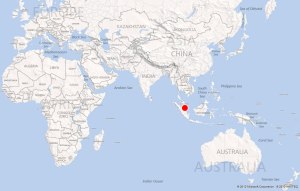I spoke at a lunch event of The Economist Corporate Network last Monday. There were about 40 CEOs and other business leaders, mostly expats but a few Singaporeans. The topic I spoke on was “The Secret to Singapore’s Success?”…complete with the question mark! I had agreed to speak as I thought the topic to be both intriguing and timely, given all the excitement building up on commemorating the 50th year of Singapore’s independence.
Often when visitors come to Singapore wondering what has been the secret sauce for Singapore’s success, they get briefed on the HDB, CPF Scheme, the education system the EDB, and so on – all true, and all relevant, but, in my mind, perhaps not a fundamental enough explanation. So I started off my talk by saying:
“If you look at an atlas of the world, Singapore, the country, fits quite nicely into the letter “o” in its name. Unlike most countries in the world whose names fit well into their boundaries in the atlas, Singapore’s name is much longer than its size. And if you look again at the atlas, Malaysia lies to the north and east of Singapore, while Indonesia lies to the west, south and east. When Singapore became, rather unexpectedly, independent in August 1965, it had to find its own way into the future: the dream of a common market in Malaysia was broken, and Indonesia was still conducting konfrantasi (military confrontation) against Singapore.”
When President B J Habibie of Indonesia referred to Singapore as a “little red dot” in 1998, he had meant it as a disparaging remark. Little would he have expected that Singapore would take it up as a badge of honour, a symbol of success despite the odds.
President Habibie had sought later to make amends by saying he had not meant “little red dot” to be disparaging: he was speaking to an Indonesian youth group, and was challenging them to seek the progress and success of Indonesia by noting that Singapore, even though just a little red dot, had been able to make a success of itself.
Singapore had reached out beyond its immediate surroundings to adopt the whole world as its hinterland, its source of capital, investment, research and technology, management capability, and, most of all, markets. Later came its growth as a global financial centre, potentially the global financial centre in Asia.
Markets are critically the reason for welcoming MNCs to Singapore, because the smallness of Singapore and its economy simply means that no company in Singapore can grow merely by serving the Singapore market: the key to growth and success lies in penetrating overseas markets, mostly in the region but also globally. Of course we would wish as many Singapore companies as possible to have such global reach, but MNCs are what multiply the reach many many times over, without shutting out the Singapore companies.
What explains Singapore’s success in drawing investments from all over the world, where companies sink their money into Singapore and are prepared to wait 10, 15 or 20 years to recover their money through successful production and business operations? What explains the many research centres to discover new knowledge and design new products, where the protection of intellectual property is the name of the game? And what explains a willingness on the part of so many foreigners to park their funds and their wealth in Singapore?
The explanation lies in an ability to trust Singapore as a place where promises are kept, the rule of law maintained, justice is assured, government policies are predictable. Singapore offers reliability, integrity, quality, hard work and trustworthiness. These are what make for long-term relationships.
Trust is the root of relationships, and honour is the foundation of trust, where the people, businesses and government deliver on their word of honour.
Singapore’s place in the community of nations obviously depends not just on trust, but on being able to mobilize talent, synergise the efforts of workers, employers and government, and superior leadership. But honour has to be the starting point and the abiding foundation.



